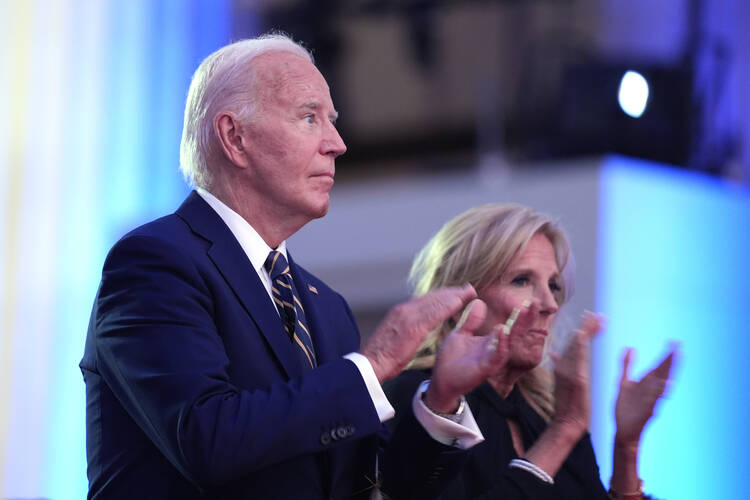‘Stop Donald Trump’ isn’t enough. The Democratic Party needs a deeper message to win the election.
Regardless of whether Joseph R. Biden Jr. remains its nominee in the 2024 presidential election, the Democratic Party still has a chance to offer voters a positive vision, one that goes beyond “stop Donald Trump.” Mr. Trump represents chaos at best, and an outright assault on democratic institutions at worst (a scenario made more plausible by the recent Supreme Court decision making it more difficult to prosecute a president for breaking the law). Either of these outcomes is alarming to someone who has economic stability, or who lives in a community that has seen less crime and more economic growth in recent decades. But there are Americans who have neither experience, and their support of Mr. Trump has made him a political force for almost a decade.
To Americans with little economic or social capital, an election is a rare opportunity to exert a tiny degree of control over the world they live in. They may opt for the status quo, but only if they have a certain degree of trust in governing institutions. By insisting for months, even years, that Mr. Biden’s age is nothing to be concerned about—in effect, telling voters, “It’s none of your business”—the Democratic Party has squandered some of that trust, even among its most reliable supporters. And after Mr. Biden’s performance in last month’s debate, it quickly became untenable to proceed with the campaign as usual. If party leaders do not call for a new nominee, they must at least ask more of the Biden campaign, including more unscripted public appearances and a more visible role for Vice President Kamala Harris, who may be called upon to assume the presidency within the next four years.
This is the minimum, but Democrats must do more than merely react to public opinion. Ever since Mr. Trump began his first presidential campaign, riding down the Trump Tower escalator in 2015, the Democratic message has been: “You have no choice. Vote for us or you’re a fascist” (or a “deplorable,” the word that Hillary Clinton used to describe some Trump voters but that quickly became synonymous with all Trump voters).
Too many people opposing Mr. Trump have adopted the us-vs.-them mentality of far-right political figures like Steve Bannon. But if the Republican Party is a threat to democratic and all civic instututions (and there is ample evidence that a second Trump administration would be such a threat), the answer is not to create a mirror image of Trumpism on the left. There is no need for a liberal version of Fox News, and no good can come from insisting that anti-Trump voters throw away their duty of discernment and accept any statement that comes from the Democratic Party, whether about the president’s health or anything else.
The Democratic Party cannot outsource its responsibility to put forth an alternative to Mr. Trump. If Mr. Trump wins in November, the Democrats must certainly act as a vigorous and vigilant opposition party, but they must also attempt to figure out why they have not been able to win a majority of voters even against an unpopular Republican Party. They cannot demand that institutions outside the electoral process—whether schools or the scientific community or the media—simply browbeat Americans into giving them power.
The Democrats must attempt to bridge real divisions in the United States, not only the divisions along economic, geographic, racial and religious lines, but also the widening political and cultural chasm between Americans of different educational levels. Democratic leaders must address housing costs and homelessness in ways that do not pit communities against each other. They must address how to help the smaller cities and rural communities that have been “left behind” by deindustrialization and globalization. (The Republicans’ neglect of big cities, as well as the underrepresentation in Congress of urban areas, can still be condemned without engaging in the same scapegoating of rural areas.)
This is a tall order with only a few months left in the campaign. But it is possible to take the first few steps, and perhaps regain the trust of enough voters to win in November. The party should look to the Democrat who earned the highest percentage of the vote since 1964, and specifically look to Barack Obama’s keynote speech at the 2004 Democratic Convention:
The pundits like to slice-and-dice our country into Red States and Blue States; Red States for Republicans, Blue States for Democrats. But I’ve got news for them, too. We worship an awesome God in the Blue States, and we don't like federal agents poking around our libraries in the Red States. We coach Little League in the Blue States and have gay friends in the Red States. There are patriots who opposed the war in Iraq and patriots who supported it. We are one people, all of us pledging allegiance to the stars and stripes, all of us defending the United States of America.
That speech may seem too sentimental now, another sign that American politics has been corroded over the past few years. But it has one big advantage in a race against Mr. Trump: the element of surprise.






No comments:
Post a Comment